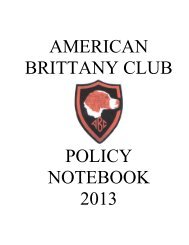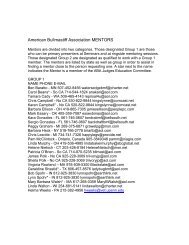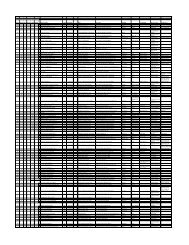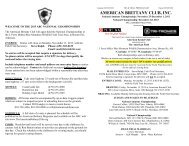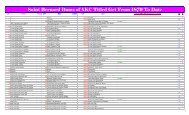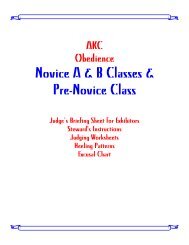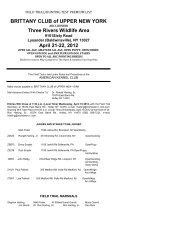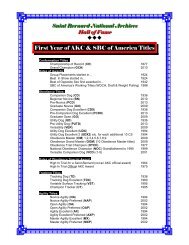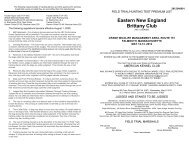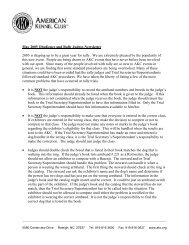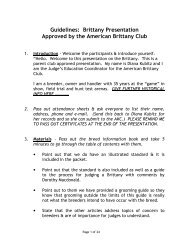The Skye Terrier - National Breed Clubs - American Kennel Club
The Skye Terrier - National Breed Clubs - American Kennel Club
The Skye Terrier - National Breed Clubs - American Kennel Club
You also want an ePaper? Increase the reach of your titles
YUMPU automatically turns print PDFs into web optimized ePapers that Google loves.
Pat Flanagan<br />
For me the <strong>Skye</strong> <strong>Terrier</strong> must be a large dog in a<br />
small package. Though he only stands 10 inches at<br />
the shoulder and his body measures twice its height<br />
in length, as measured from the breast bone to over<br />
the rump, he must have bone and substance, without<br />
coarseness. <strong>The</strong> bitches should be only slightly<br />
smaller than the males and not lacking in bone or<br />
substance, but appropriate for her ½ inch less in<br />
height. Add to this a long flowing neck into a well<br />
laid back shoulder which continues to a level topline<br />
giving the <strong>Skye</strong> its elegance. His head and muzzle<br />
should be strong and powerful with no snippiness of<br />
muzzle or lack of fill under the eyes. On the move, a<br />
<strong>Skye</strong>’s front legs should travel well forward with reach<br />
while the rear legs propel with drive. This movement<br />
should be fluid and never choppy or stilted. <strong>The</strong> overall<br />
appearance should be one of balance.<br />
Walter F. Gooman<br />
<strong>The</strong> standard of perfection of any breed is a<br />
subjective interpretation. It is how one person<br />
pictures a breed’s written ideal. As a breeder of<br />
<strong>Skye</strong> <strong>Terrier</strong>s for fifty years, I will attempt to keep<br />
this article objective. In general terms this is how<br />
I view <strong>Skye</strong> <strong>Terrier</strong>s.<br />
Anna Katherine Nicholas is a good friend of <strong>Skye</strong><br />
<strong>Terrier</strong>s and the author of two fine books about<br />
the breed. She feels the key words in judging are<br />
type, balance, style, soundness, and condition.<br />
“<strong>The</strong> ability to understand, recognize, and evaluate<br />
these qualities is essential to judge,” she says, and I<br />
agree with her completely.<br />
Type is breed character. It is the combination of<br />
distinguishing features which add up and make the<br />
individuality of a breed. <strong>Skye</strong> <strong>Terrier</strong>s are long and<br />
low and their breed type can be abused by fanciers.<br />
Type should not be a matter of personal preference,<br />
but an adherence to desired breed characteristics as<br />
stated in the Standard. <strong>The</strong>re are variations in size<br />
or bone, but subsequently type should remain constant.<br />
Those <strong>Skye</strong>s that adhere closely to the written<br />
word are obviously nearer to correct type.<br />
Balance perhaps is easier to understand, since there<br />
are clear dimensions involved. A correct <strong>Skye</strong> is wellproportioned<br />
– length of head to length of neck,<br />
to length of back and tail and height. A <strong>Skye</strong> with<br />
correct proportions can look short-backed. A <strong>Skye</strong><br />
who may be lower with a shorter neck and head,<br />
but with the same length of back as the latter dog,<br />
is unbalanced. <strong>Skye</strong>s can be too long as well as too<br />
short. Usually a properly proportioned dog stands<br />
out because of correct balance.<br />
Style becomes the next ingredient. It comes from<br />
that proper balance combined with showmanship<br />
and personality. A dog of lesser quality but with<br />
showmanship tends to conceal many of his faults.<br />
Soundness is more difficult to describe. In dog show<br />
parlance, soundness refers to proper action or movement.<br />
<strong>The</strong> standard is quite specific as to shoulder<br />
placement and front assembly as well as the rear<br />
quarter. It tells us what to expect as the dog moves<br />
towards you or away from you or as you view it in<br />
profile. To me a proper moving <strong>Skye</strong> is not only<br />
sound but typey. In other words, a correct <strong>Skye</strong> is<br />
a sound <strong>Skye</strong>. <strong>Skye</strong>s should drive from behind. If<br />
the front seems unable to keep up, it means that<br />
the front assembly is not completely correct. Often<br />
the questionable movement of the topline is the<br />
give-away of labored action. Equally unpleasant is<br />
a lack of drive front he Quarter. This is every bit as<br />
unsound and not typey.<br />
page 31



